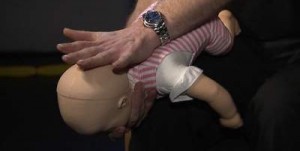13 April 2014
The EcoWaste Coalition (a waste and pollution watchdog), Philippine Pediatric Society (a professional association of pediatricians) and Arugaan (a breastfeeding advocacy and support group) organized a “Science Talk” that drew over 50 participants from the healthcare sector, the government and the civil society, including community women, to discuss the importance of determining these toxins in pregnant women and how environmental bio-monitoring can provide a window to the maternal-fetal unit.
Dr Roy Roberto Gerona, a visiting Filipino scientist/clinical toxicologist (based at the Department of Laboratory Medicine,
University of California in San Francisco, USA) wanted to draw public attention to environmental chemicals that are finding their way to human bodies, especially among pregnant women who may pass these substances to their budding fetuses through the placenta.
Mommy Abi, me, Velvet, Jenny protesting to the media
____________________________________________________________
Taken from
Ecowaste Site:
Among these environmental toxins are endocrine disrupting chemicals, or EDCs, that are structurally similar to endocrine hormones such as estrogen, testosterone, insulin and thyroxine, and which can mimic and interfere with their normal functions, Dr. Gerona explained.
These EDCs comprise most consumer products as like bisphenol A (BPA) in polycarbonate reusable drinking bottles,
baby feeding bottles, carbonless thermal papers, rust-protection resins in canned drinks and foods; phthalates used as plasticizers in toys, medical devices, adhesives and glues, enteric coatings of capsules; perfluorinated compounds (PFCs) in Teflon and Scotchgard; polybrominated diphenyl ethers (PBDEs) used as flame retardants in polyurethane foams, electronics, furniture, and textiles. He added that these EDCs are also found in some pesticides such as glyphosate (Roundup), DDT, and atrazine.
“Endocrine hormones regulate the homeostatic (steady state) function of our bodies, including reproductive health, cardiovascular health and digestive and metabolic health, among others. Thus, chronic exposure to
EDCs disrupts hormone action and is associated with various clinical endpoints including higher predisposition to cancer, cardiovascular diseases, obesity and metabolic syndrome,” he explained.
“Because the levels of hormones in our bodies are also quite low, low level exposures to EDCs affect their function,” he pointed out.
“Because the correct balance of hormone levels is crucial at specific time points in fetal development, the fetus is more vulnerable to the effects of EDCs,” he added.
“Pregnant women’s exposure to EDCs is transmitted to the developing fetuses in their wombs through the placenta. Some EDCs and their metabolites (breakdown products) cross the placenta,” he said.
Exposure of the fetus to EDCs during its development has been associated with immediate pathological effects such as crytorchidism (undescended testicles) and hypospadias (delayed penile shaft opening) or long-term epigenetic effects manifested in higher predisposition to various clinical endpoints such as diabetes, obesity, and cancer later in life, Dr. Gerona said.
Environmental biomonitoring, Dr. Gerona said, is the process of determining the body burden of toxic substances and their metabolites in human samples such as blood, urine, breast milk, etc.
This entails measuring the levels of environmental chemicals using modern analytical instrumentation including gas chromatography- mass spectrometry (GC-MS) and liquid chromatography- mass spectrometry (LC-MS), he explained.
At the “Science Talk,” Dr. Gerona also spoke about “non-targeted analysis” of EDCs and how newer LC-MS technologies can help in understanding environmental toxins in pregnant women, including the identification of previously unmeasured chemicals that can be of concern to the nascent fetus.
____________________________________________________________
Lessons learned:
- avoid plastic bottles - go for glass bottles and containers
- avoid canned acidic foods - go for fresh/locally/ingenious fruits and vegetables
- changing our eating habits will enable our bodies to excrete out the toxins, given ample time and minimal to no toxins. we can be toxin-free, if we give our bodies time to "heal".
Not only did the talk got a wonderful response in the community, it also
got a news worthy feature on the afternoon show, Balitanghali.












